|

 Up
Up 
 The Wright/
Smithsonian
The Wright/
Smithsonian
Controversy

(You are here.)
 Down
Down




  Need
to Need
to
find your
bearings?
Try
these
navigation aids:
If
this is your first
visit, please stop by:
Something
to share?
Please:



|
|
Available in Française, Español, Português, Deutsch, Россию,
中文,
日本, and others.
 n
early 1914, the Smithsonian Institution lent Glenn Curtiss the
remains of the 1903 Langley Aerodrome. This was the manned aircraft
that Samuel P. Langley, then the Secretary of the Smithsonian, had
tried to fly right before the Wright brothers made their first
successful powered flights at Kitty Hawk in 1903. Actually,
Langley had
tried to fly the Aerodrome twice on 7 October and 8 December 1903 and failed
both times. Curtiss rebuilt the Aerodrome, making significant
changes to the airframe, wings, drive train, and controls.
He then managed to make
a few hop-flights off the surface of a lake near Hammondsport,
NY. None of these lasted more than a few seconds nor could they be
sustained for longer than a few hundred feet. Nonetheless, both
Glenn Curtiss and the Smithsonian crowed that these flights proved
that the Langley Aerodrome had been "capable" of flight in 1903. It
was, they insisted, the first true aircraft. n
early 1914, the Smithsonian Institution lent Glenn Curtiss the
remains of the 1903 Langley Aerodrome. This was the manned aircraft
that Samuel P. Langley, then the Secretary of the Smithsonian, had
tried to fly right before the Wright brothers made their first
successful powered flights at Kitty Hawk in 1903. Actually,
Langley had
tried to fly the Aerodrome twice on 7 October and 8 December 1903 and failed
both times. Curtiss rebuilt the Aerodrome, making significant
changes to the airframe, wings, drive train, and controls.
He then managed to make
a few hop-flights off the surface of a lake near Hammondsport,
NY. None of these lasted more than a few seconds nor could they be
sustained for longer than a few hundred feet. Nonetheless, both
Glenn Curtiss and the Smithsonian crowed that these flights proved
that the Langley Aerodrome had been "capable" of flight in 1903. It
was, they insisted, the first true aircraft.
Griffith Brewer, an English patent attorney and a friend of
Orville's, was visiting the United States at the time. At Orville's
request, he traveled to Hammondsport to see what was going on. He
shot photos that documented the changes made to Langley's aircraft,
then fired off a letter to the New York Times charging that the
flights did not prove that the Langley Aerodrome was airworthy in
its original configuration. This letter touched off a controversy
that raged for almost thirty years, pitting Orville Wright against
the Smithsonian Institution.
The reasons that Glenn Curtiss had made these test flights were purely
commercial. He had lost the patent suit that the Wrights had filed
against him; the courts had ruled not just that the control systems
of Curtiss aircraft were derivative of the Wright's patented system,
but also the Wright system was necessary for aerial navigation,
period. It was the "pioneer patent" of the aircraft industry. By
flying the Langley Aerodrome, Curtiss was attempting to show that
another airplane could have successfully navigated the air before
the Wrights. Therefore their patent was not entitled to the pioneer status
the courts had given it.
The Smithsonian's interest in
these flights was political. The reputation of the Smithsonian
had suffered greatly in 1903 when Langley's Aerodrome failed to fly.
This made it more difficult to obtain funding, which limited its
growth and effectiveness as a scientific organization. The current
Secretary, Charles Walcott, felt that the best way to repair this
reputation was the show the Aerodrome could have flown; the time and
money spent on it had not been wasted.
Walcott also had a vested interest in the Aerodrome; it's failure
had affected his reputation as well.
He had been involved with the
project from its inception in 1898; it was Walcott that had
found the backing Langley needed to build the aircraft. When he took
over the Smithsonian from Langley in 1906, both the institution and
its Secretary were tarnished in the eyes of many.
Walcott immediately began
to rebuild his political effectiveness and that of the Smithsonian
by rehabilitating the memory of Samuel Langley. He created a
Langley Medal for outstanding contributions to aeronautics, erected
a Langley memorial tablet to immortalize Langley's own contribution,
even decreed a "Langley Day" to remember his many scientific
triumphs.
In 1914, there was
talk of creating a national aeronautics laboratory with an advisory
council to direct research and encourage the growth of this new
industry. Walcott wanted to re-open Langley's aeronautical workshop
at the Smithsonian to serve this function, but the Smithsonian was
just one of several organizations that were vying for this honor –
and its attendant funding.
When the opportunity
came to rebuild and fly the Aerodrome, Walcott moved quickly to
make it happen. A successful flight, properly presented in the
press, would go a long way toward restoring the Smithsonian's
reputation. This in turn might convince Congress that the
Smithsonian would be a good place to conduct aeronautics research. Within days of concluding an
agreement with Curtiss, he shipped the remains of the Aerodrome to
Hammondsport.
Once Curtiss got his hands on the old aircraft, he discovered
problems and weaknesses that affected its airworthiness. He chose
not to launch it in its original condition and instead
made changes that
would enhance its performance, controllability, and structural
integrity. The aircraft that flew in Hammondsport was, as Brewer
had claimed, not the same that Langley had tried to launch in 1903.
Curtiss and the Smithsonian, however, insisted it was close enough.
No matter, the flights did not achieve their objectives – events
marched past the Hammondsport trials.
Congress created the National
Advisory Council for Aeronautics (NACA) independent of the
Smithsonian, and NACA created a patent pool, the Manufacturers
Aircraft Association (MAA), that resolved Curtiss' patent dilemma.
The Smithsonian, however, could not back away from its conclusion that
the Langley Aerodrome was the first man-carrying powered aircraft
"capable of sustained flight." It published reports that
repeated these claims in the Smithsonian Annual Reports beginning in
1914 through 1918. And in 1918, it displayed a newly-restored
Langley Aerodrome in the Arts and Industries Building with a label
that claimed it was the first aircraft "capable" of flight. As
evidenced by books and magazines that were published during that
time, the public began to believe that Langley was the "father of
flight."
To counter the Smithsonian, Orville restored the 1903 Wright
Flyer I and began to show it at special venues. Several friends
came to his defense, including
Griffith Brewer who rallied all of England to Orville's cause. In 1921, Brewer gave a speech to the Royal Academy of
Science in England that listed the
changes to the Aerodrome that were necessary to make it fly and
exposed the deception. It was simultaneously published in
America, and caused a great uproar in the aviation community. The
uproar spread to the general public in 1925 when Orville announced
that he would send the 1903 Wright Flyer to the Kensington Science Museum in
England unless the Smithsonian recanted. He finally sent the Flyer in 1928
and published his reasons. “I believe my course in sending our Kitty
Hawk machine to a foreign museum is the only way of correcting the
history of the flying machine, which by false and misleading
statements has been perverted by the Smithsonian Institution.”
By this time, the Smithsonian had changed Secretaries again.
Charles Abbot had taken over for Charles Walcott when the latter
died. Abbot was a close personal friend of Langley and was every
bit as mindful of Washington politics as Walcott. He tried to
negotiate a truce with Orville in 1929, but balked when Orville
demanded he publish a list of changes that had been made to the
Aerodrome and to retract the statement that it was capable of flight
in its 1903 configuration. Abbot told Orville that he could not do
anything that would embarrass the Smithsonian or the late Walcott.
He balked again in 1934 when Charles Lindbergh tried to mediate
the disagreement. But Abbot finally
acceded in 1942 when Fred C. Kelly informed him that he was
writing an "authorized" autobiography of the Wright brothers and had
promised Orville that he would mend fences if he could. Kelly
warned Abbot that this biography would have a section on the
Wright/Smithsonian controversy. If the book went to press with the
controversy unresolved, it would be a source of embarrassment for
decades. Furthermore, Orville was an old man. If he died before
amends could be made, the embarrassment would be permanent. It would
be better to end the standoff, even if the Smithsonian had
to admit it was wrong. In a Smithsonian Miscellaneous
Report, issued in 1942, Abbot published the list of changes that Orville had asked for,
admitted the 1914 test flights did not prove the Aerodrome was
capable of flight in 1903, and
apologized for the affair.
When Abbot next saw Orville, all seemed forgiven. At a special
dinner honoring the Wright brothers in Washington DC on 17 December
1943, and with the approval of both Orville Wright and Charles
Abbot, Secretary of Commerce Jesse Jones read an announcement
from President Franklin D. Roosevelt that the Flyer would be
returning to America and "the nation will welcome it back as the
outstanding example of American genius.”
More
Information
For a detailed account of the Wright/Smithsonian Controversy,
follow the pages listed in the navigation column (left), beginning
with The Flight of the
Langley Aerodrome. We have also collected these pages, along
with much additional information and resources, in a
printer-friendly file,
Politically
Incorrect: The Flights and Fights Surrounding the 1914 Tests of the
Langley Aerodrome.
|

The U.S. Army had funded
Langley's "Aerodrome A," paying the Smithsonian $50,000 to develop a
manned aircraft. Like Langley's smaller aerodromes, this was
launched by a catapult atop a houseboat.

On both launch attempts in 1903, the Aerodrome had failed to
fly. Langley blamed the catapult, claiming that the airplane was
airworthy but the launching mechanism had failed.

When Curtiss rebuilt the Aerodrome in 1914, he discarded the catapult
and attached pontoons so the aircraft could take off from the water.
He also made changes to strengthen the structure and improve lift.
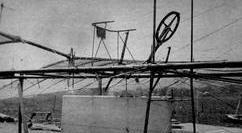
The Curtiss controls that were installed in the Aerodrome in 1914.
At the extreme left, the sharp leading edges of the wings have been
removed, altering the camber, angle of attack, and aspect ratio.
These were two of the many changes that Glenn Curtiss made to the
Aerodrome to make it modestly airworthy.
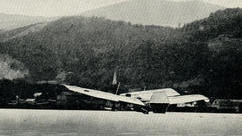
The improvements were just enough to get the Aerodrome off the water
for few seconds. It was not able to make sustained flights until
Curtiss made more changes, including a new engine and
propeller.
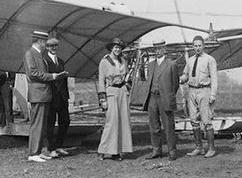
In front of the Aerodrome, from left to right, Charles Walcott,
Glenn Curtiss, Walcott's daughter Helen, Albert Zahm and C.C.
Wittmer, a Curtiss pilot.
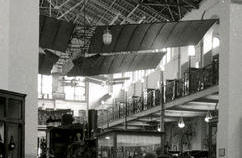
After the test flights, the Aerodrome was restored to its 1903
configuration and displayed in the Smithsonian with a placard
claiming it to be "the first man-carrying aeroplane in the history
of the world capable of sustained free flight."

The 1903 Wright Flyer in the Kensington Science Museum in London,
1928.
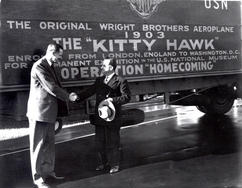
Paul Garber (right) of the Smithsonian Institution welcomes the
Flyer back to America in 1948.
|

